Exploiting TERRA-AQUA MODIS Relationship in the Reflective Solar Bands for Aerosol Retrieval
Abstract
:1. Introduction
2. Methodology
2.1. Atmospheric Absorption and Scattering
2.2. Analytical Representation of Path Radiance
2.3. Treatment of BRDF Effect
2.4. TERRA-AQUA MODIS Relationship and AOT Retrieval
- (1)
- Daily cloud-free TERRA and AQUA MODIS observations (ρTOA) are available;
- (2)
- Ozone and water vapor data are available to calculate Tg;
- (3)
- The BRDF effects are accounted for by fBRDF;
- (4)
- The relation between atmospheric scattering transmittance (T) and AOT is specified;
- (5)
- The relation between path radiance (ρpath) and AOT is specified.
2.5. Sensitivity Analysis
3. Study Materials and Data Preprocessing
3.1. Radiative Transfer Calculations
3.2. Processing of BRDF Data
3.3. Validation of TERRA-AQUA MODIS Relationship
3.4. Assignments for Sensitivity Analysis
4. Results
4.1. Validation Results of the Ratioing Technique
4.2. The Performance of Path Radiance Approximation
4.3. Validation Results of the MODIS-MODIS Relationship
4.3.1. Comparisons with MODIS Reflectances
4.3.2. Comparisons with MODIS AOT Retrievals
4.3.3. Comparisons with Sun Photometer AOT Retrievals
4.4. The Sensitivity of Aerosol Retrieval to Critical Factors
4.4.1. Angular Difference
4.4.2. Land Surface
4.4.3. BRDF Characterization
5. Discussion
5.1. The Band Ratioing Technique for Aerosol Retrieval
5.2. The Expalantions of Path Radiance Approximations
5.3. Examination of the Continental Aerosol Model for Aerosol Retrieval
5.4. Contributions and Limitations of the Synergetic Method
6. Conclusions
Acknowledgments
Author Contributions
Conflicts of Interest
References
- Stowe, L.L.; Jacobowitz, H.; Ohring, G.; Knapp, K.R.; Nalli, N.R. The advanced very high resolution radiometer (AVHRR) pathfinder atmosphere (PATMOS) climate dataset: Initial analyses and evaluations. J. Clim. 2002, 15, 1243–1260. [Google Scholar] [CrossRef]
- Mishchenko, M.I.; Geogdzhayev, I.V.; Cairns, B.; Carlson, B.E.; Chowdhary, J.; Lacis, A.A.; Liu, L.; Rossow, W.B.; Travis, L.D. Past, present, and future of global aerosol climatologies derived from satellite observations: A perspective. J. Quant. Spectrosc. Radiat. Transfer 2007, 106, 325–347. [Google Scholar] [CrossRef]
- Intergovernmental Panel on Climate Change (IPCC). Climate Change 2013: The Physical Science Basis. Contribution of Working Group I to the Fifth Assessment Report of the Intergovernmental Panel on Climate Change; Stocker, T.F., Qin, D., Plattner, G.-K., Tignor, M., Allen, S.K., Boschung, J., Nauels, A., Xia, Y., Bex, V., Midgley, P.M., Eds.; Cambridge University Press: Cambridge, UK; New York, NY, USA, 2013. [Google Scholar]
- Li, Z.; Zhao, X.; Kahn, R.; Mishchenko, M.; Remer, L.; Lee, K.H.; Wang, M.; Laszlo, I.; Nakajima, T.; Maring, H. Uncertainties in satellite remote sensing of aerosols and impact on monitoring its long-term trend: A review and perspective. Ann. Geophys. 2009, 27, 2755–2770. [Google Scholar] [CrossRef]
- Wong, M.S.; Nichol, J.E.; Lee, K.H. An operational MODIS aerosol retrieval algorithm at high spatial resolution, and its application over a complex urban region. Atmos. Res. 2011, 99, 579–589. [Google Scholar] [CrossRef]
- Bilal, M.; Nichol, J.E.; Bleiweiss, M.P.; Dubois, D. A simplified high resolution MODIS Aerosol Retrieval Algorithm (SARA) for use over mixed surfaces. Remote Sens. Environ. 2013, 136, 135–145. [Google Scholar] [CrossRef]
- Vermote, E.F.; Tanré, D.; Deuze, J.L.; Herman, M.; Morcette, J.J. Second simulation of the satellite signal in the solar spectrum, 6S: An overview. IEEE Trans. Geosci. Remote Sens. 1997, 35, 675–686. [Google Scholar] [CrossRef]
- King, M.D.; Kaufman, Y.J.; Tanré, D.; Nakajima, T. Remote sensing of tropospheric aerosols from space: Past, present, and future. Bull. Am. Meteorol. Soc. 1999, 80, 2229–2259. [Google Scholar] [CrossRef]
- Stowe, L.L.; Ignatov, A.M.; Singh, R.R. Development, validation, and potential enhancements to the second-generation operational aerosol product at the National Environmental Satellite, Data, and Information Service of the National Oceanic and Atmospheric Administration. J. Geophys. Res. 1997, 102, 16923–16934. [Google Scholar] [CrossRef]
- Li, Y.; Xue, Y.; de Leeuw, G.; Li, C.; Yang, L.; Hou, T.; Marir, F. Retrieval of aerosol optical depth and surface reflectance over land from NOAA AVHRR data. Remote Sens. Environ. 2013, 133, 1–20. [Google Scholar] [CrossRef]
- Omar, A.H.; Won, J.G.; Winker, D.M.; Yoon, S.C.; Dubovik, O.; McCormick, M.P. Development of global aerosol models using cluster analysis of Aerosol Robotic Network (AERONET) measurements. J. Geophys. Res. 2005, 110. [Google Scholar] [CrossRef]
- Levy, R.C.; Remer, L.A.; Dubovik, O. Global aerosol optical properties and application to Moderate Resolution Imaging Spectroradiometer aerosol retrieval over land. J. Geophys. Res. 2007, 112. [Google Scholar] [CrossRef]
- Kaufman, Y.J.; Tanré, D.; Remer, L.A.; Vermote, E.F.; Chu, A.; Holben, B.N. Operational remote sensing of tropospheric aerosol over land from EOS moderate resolution imaging spectroradiometer. J. Geophys. Res. 1997, 102, 17051–17067. [Google Scholar] [CrossRef]
- Remer, L.A.; Kaufman, Y.J.; Tanré, D.; Mattoo, S.; Chu, D.A.; Martins, J.V.; Li, R.R.; Ichoku, C.; Levy, R.C.; Kleidman, R.G.; et al. The MODIS aerosol algorithm, products, and validation. J. Atmos. Sci. 2005, 62, 947–973. [Google Scholar] [CrossRef]
- Oo, M.M.; Jerg, M.; Hernandez, E.; Picon, A.; Gross, B.M.; Moshary, F.; Ahmed, S.A. Improved MODIS aerosol retrieval using modified VIS/SWIR surface albedo ratio over urban scenes. IEEE Trans. Geosci. Remote Sens. 2010, 48, 983–1000. [Google Scholar] [CrossRef]
- Hsu, N.C.; Tsay, S.C.; King, M.D.; Herman, J.R. Aerosol properties over bright-reflecting source regions. IEEE Trans. Geosci. Remote Sens. 2004, 42, 557–569. [Google Scholar] [CrossRef]
- Hsu, N.C.; Jeong, M.J.; Bettenhausen, C.; Sayer, A.M.; Hansell, R.; Seftor, C.S.; Huang, J.; Tsay, S.C. Enhanced Deep Blue aerosol retrieval algorithm: The second generation. J. Geophys. Res. 2013, 118, 9296–9315. [Google Scholar] [CrossRef]
- Levy, R.C.; Remer, L.A.; Kleidman, R.G.; Mattoo, S.; Ichoku, C.; Kahn, R.; Eck, T.F. Global evaluation of the Collection 5 MODIS dark-target aerosol products over land. Atmos. Chem. Phys. 2010, 10, 10399–10420. [Google Scholar] [CrossRef] [Green Version]
- Bilal, M.; Nichol, J.E. Evaluation of MODIS aerosol retrieval algorithms over the Beijing-Tianjin-Hebei region during low to very high pollution events. J. Geophys. Res. 2015, 120, 7941–7957. [Google Scholar] [CrossRef]
- Sayer, A.M.; Munchak, L.A.; Hsu, N.C.; Levy, R.C.; Bettenhausen, C.; Jeong, M.J. MODIS Collection 6 aerosol products: Comparison between Aqua's e-Deep Blue, Dark Target, and “merged” data sets, and usage recommendations. J. Geophys. Res. 2014, 119, 13965–13989. [Google Scholar] [CrossRef]
- Tao, M.; Chen, L.; Wang, Z.; Tao, J.; Che, H.; Wang, X.; Wang, Y. Comparison and evaluation of the MODIS Collection 6 aerosol data in China. J. Geophys. Res. 2015, 120, 6992–7005. [Google Scholar] [CrossRef]
- Li, C.; Lau, A.H.; Mao, J.; Chu, D.A. Retrieval, validation, and application of the 1-km aerosol optical depth from MODIS measurements over Hong Kong. IEEE Trans. Geosci. Remote Sens. 2005, 43, 2650–2658. [Google Scholar]
- Wang, Y.; Xue, Y.; Li, Y.; Guang, J.; Mei, L.; Xu, H.; Ai, J. Prior knowledge-supported aerosol optical depth retrieval over land surfaces at 500 m spatial resolution with MODIS data. Int. J. Remote Sens. 2012, 33, 674–691. [Google Scholar] [CrossRef]
- Bilal, M.; Nichol, J.E.; Chan, P.W. Validation and accuracy assessment of a Simplified Aerosol Retrieval Algorithm (SARA) over Beijing under low and high aerosol loadings and dust storms. Remote Sens. Environ. 2014, 153, 50–60. [Google Scholar] [CrossRef]
- Lee, K.H.; Li, Z.; Kim, Y.J.; Kokhanovsky, A. Atmospheric aerosol monitoring from satellite observations: A history of three decades. In Atmospheric and Biological Environmental Monitoring; Springer: Heidelberg, Germany, 2009; pp. 13–38. [Google Scholar]
- Martonchik, J.V.; Diner, D.J. Retrieval of aerosol optical properties from multi-angle satellite imagery. IEEE Trans. Geosci. Remote Sens. 1992, 30, 223–230. [Google Scholar] [CrossRef]
- Diner, D.J.; Martonchik, J.V.; Kahn, R.A.; Pinty, B.; Gobron, N.; Nelson, D.L.; Holben, B.N. Using angular and spectral shape similarity constraints to improve MISR aerosol and surface retrievals over land. Remote Sens. Environ. 2005, 94, 155–171. [Google Scholar] [CrossRef]
- Tanré, D.; Bréon, F.M.; Deuzé, J.L.; Dubovik, O.; Ducos, F.; François, P.; Goloub, P.; Herman, M.; Lifermann, A.; Waquet, F. Remote sensing of aerosols by using polarized, directional and spectral measurements within the A-Train: The PARASOL mission. Atmos. Meas. Tech. 2011, 4, 1383–1395. [Google Scholar] [CrossRef] [Green Version]
- Zhang, Y.; Li, Z.; Qie, L.; Zhang, Y.; Liu, Z.; Chen, X.; Hou, W.; Li, K.; Xu, H. Retrieval of aerosol fine-mode fraction from intensity and polarization measurements by PARASOL over East Asia. Remote Sens. 2016, 8, 417. [Google Scholar] [CrossRef]
- Davies, W.H.; North, P.R.; Grey, W.M.; Barnsley, M.J. Improvements in aerosol optical depth estimation using multiangle CHRIS/PROBA images. IEEE Trans. Geosci. Remote Sens. 2010, 48, 18–24. [Google Scholar] [CrossRef]
- Martonchik, J.V.; Diner, D.J.; Kahn, R.A.; Ackerman, T.P.; Verstraete, M.M.; Pinty, B.; Gordon, H.R. Techniques for the retrieval of aerosol properties over land and ocean using multiangle imaging. IEEE Trans. Geosci. Remote Sens. 1998, 36, 1212–1227. [Google Scholar] [CrossRef]
- Veefkind, J.P.; de Leeuw, G.; Durkee, P.A. Retrieval of aerosol optical depth over land using two-angle view satellite radiometry during TARFOX. Geophys. Res. Lett. 1998, 25, 3135–3138. [Google Scholar] [CrossRef]
- Veefkind, J.P.; de Leeuw, G.; Stammes, P.; Koelemeijer, R.B. Regional distribution of aerosol over land, derived from ATSR-2 and GOME. Remote Sens. Environ. 2000, 74, 377–386. [Google Scholar] [CrossRef]
- Tang, J.; Xue, Y.; Yu, T.; Guan, Y. Aerosol optical thickness determination by exploiting the synergy of TERRA and AQUA MODIS. Remote Sens. Environ. 2005, 94, 327–334. [Google Scholar] [CrossRef]
- Rahman, H.; Dedieu, G. SMAC: A simplified method for the atmospheric correction of satellite measurements in the solar spectrum. Int. J. Remote Sens. 1994, 15, 123–143. [Google Scholar] [CrossRef]
- Kaufman, Y.J. Aerosol optical thickness and atmospheric path radiance. J. Geophys. Res. 1993, 98, 2677–2692. [Google Scholar] [CrossRef]
- Oliveros, C.S.; Reyes, F.O.; Alados-Arboledas, L. Determination of aerosol optical thickness from measurements of spectral sky radiance. J. Aerosol Sci. 1998, 29, 1199–1211. [Google Scholar] [CrossRef]
- Fan, X.; Liu, Y. Quantifying the relationship between intersensor images in solar reflective bands: Implications for intercalibration. IEEE Trans. Geosci. Remote Sens. 2014, 52, 7727–7737. [Google Scholar]
- Fan, X.; Liu, Y.; Tao, J.; Weng, Y. Soil salinity retrieval from advanced multi-spectral sensor with partial least square regression. Remote Sens. 2015, 7, 488–511. [Google Scholar] [CrossRef]
- Antoine, D.; Morel, A. Relative importance of multiple scattering by air molecules and aerosols in forming the atmospheric path radiance in the visible and near-infrared parts of the spectrum. Appl. Opt. 1998, 37, 2245–2259. [Google Scholar] [CrossRef] [PubMed]
- Deuzé, J.L.; Bréon, F.M.; Devaux, C.; Goloub, P.H.; Herman, M.; Lafrance, B.; Maignan, F.; Marchand, A.; Nadal, F.; Perry, G.; et al. Remote sensing of aerosols over land surfaces from POLDER-ADEOS-1 polarized measurements. J. Geophys. Res. 2001, 106, 4913–4926. [Google Scholar] [CrossRef]
- El Saleous, N.Z.; Vermote, E.F.; Justice, C.O.; Townshend, J.R.G.; Tucker, C.J.; Goward, S.N. Improvements in the global biospheric record from the advanced very high resolution radiometer (AVHRR). Int. J. Remote Sens. 2000, 21, 1251–1277. [Google Scholar] [CrossRef]
- Sharma, S.K. A review of approximate analytic light-scattering phase functions. In Light Scattering Reviews 9; Springer: Berlin, Germany, 2015; pp. 53–100. [Google Scholar]
- Draine, B.T. Scattering by interstellar dust grains. I. Optical and ultraviolet. Astrophys. J. 2003, 598, 1017–1025. [Google Scholar] [CrossRef]
- Flowerdew, R.J.; Haigh, J.D. An approximation to improve accuracy in the derivation of surface reflectances from multi-look satellite radiometers. Geophys. Res. Lett. 1995, 22, 1693–1696. [Google Scholar] [CrossRef]
- Vermote, E.; Justice, C.O.; Bréon, F.M. Towards a generalized approach for correction of the BRDF effect in MODIS directional reflectances. IEEE Trans. Geosci. Remote Sens. 2009, 47, 898–908. [Google Scholar] [CrossRef]
- Kotchenova, S.Y.; Vermote, E.F.; Matarrese, R.; Klemm, F.J., Jr. Validation of a vector version of the 6S radiative transfer code for atmospheric correction of satellite data. Part I: Path radiance. Appl. Opt. 2006, 45, 6762–6774. [Google Scholar] [CrossRef] [PubMed]
- Kotchenova, S.Y.; Vermote, E.F. Validation of a vector version of the 6S radiative transfer code for atmospheric correction of satellite data. Part II. Homogeneous Lambertian and anisotropic surfaces. Appl. Opt. 2007, 46, 4455–4464. [Google Scholar] [CrossRef] [PubMed]
- Remer, L.A.; Wald, A.E.; Kaufman, Y.J. Angular and seasonal variation of spectral surface reflectance ratios: Implications for the remote sensing of aerosol over land. IEEE Trans. Geosci. Remote Sens. 2001, 39, 275–283. [Google Scholar] [CrossRef]
- Bassani, C.; Cavalli, R.M.; Antonelli, P. Influence of aerosol and surface reflectance variability on hyperspectral observed radiance. Atmos. Meas. Tech. 2012, 5, 1193–1203. [Google Scholar] [CrossRef] [Green Version]
- Bassani, C.; Manzo, C.; Braga, F.; Bresciani, M.; Giardino, C.; Alberotanza, L. The impact of the microphysical properties of aerosol on the atmospheric correction of hyperspectral data in coastal waters. Atmos. Meas. Tech. 2015, 8, 1593–1604. [Google Scholar] [CrossRef]
- Dubovik, O.; Smirnov, A.; Holben, B.N.; King, M.D.; Kaufman, Y.J.; Eck, T.F.; Slutsker, I. Accuracy assessments of aerosol optical properties retrieved from Aerosol Robotic Network (AERONET) Sun and sky radiance measurements. J. Geophys. Res. 2000, 105, 9791–9806. [Google Scholar] [CrossRef]
- Tirelli, C.; Curci, G.; Manzo, C.; Tuccella, P.; Bassani, C. Effect of the aerosol model assumption on the atmospheric correction over land: Case studies with CHRIS/PROBA hyperspectral images over Benelux. Remote Sens. 2015, 7, 8391–8415. [Google Scholar] [CrossRef] [Green Version]
- Mielonen, T.; Arola, A.; Komppula, M.; Kukkonen, J.; Koskinen, J.; de Leeuw, G.; Lehtinen, K.E.J. Comparison of CALIOP level 2 aerosol subtypes to aerosol types derived from AERONET inversion data. Geophys. Res. Lett. 2009, 36. [Google Scholar] [CrossRef]
- Fan, X.W.; Liu, Y.B. A global study of NDVI difference among moderate-resolution satellite sensors. ISPRS J. Photogramm. Remote Sen. 2016, 121, 177–191. [Google Scholar] [CrossRef]
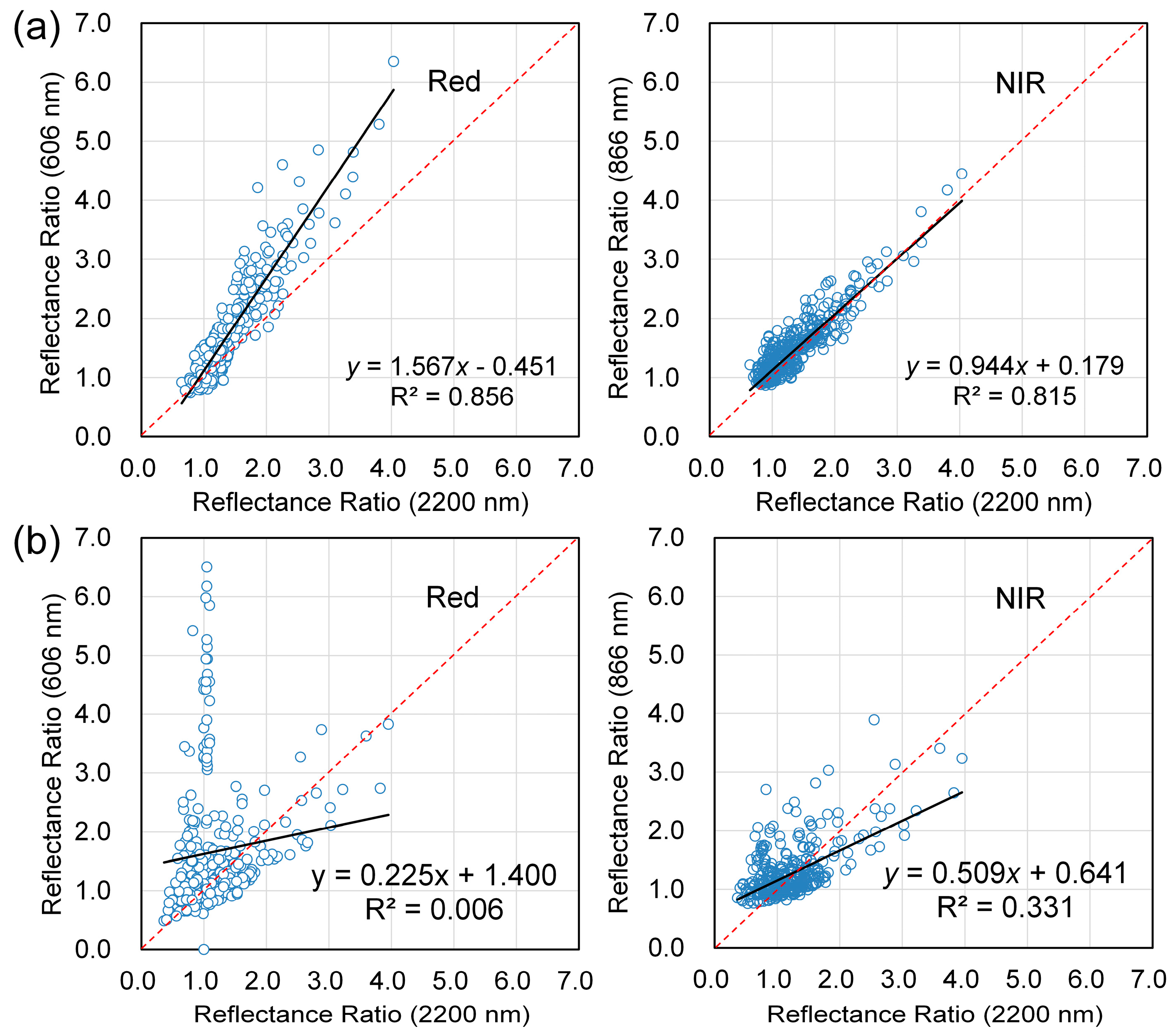
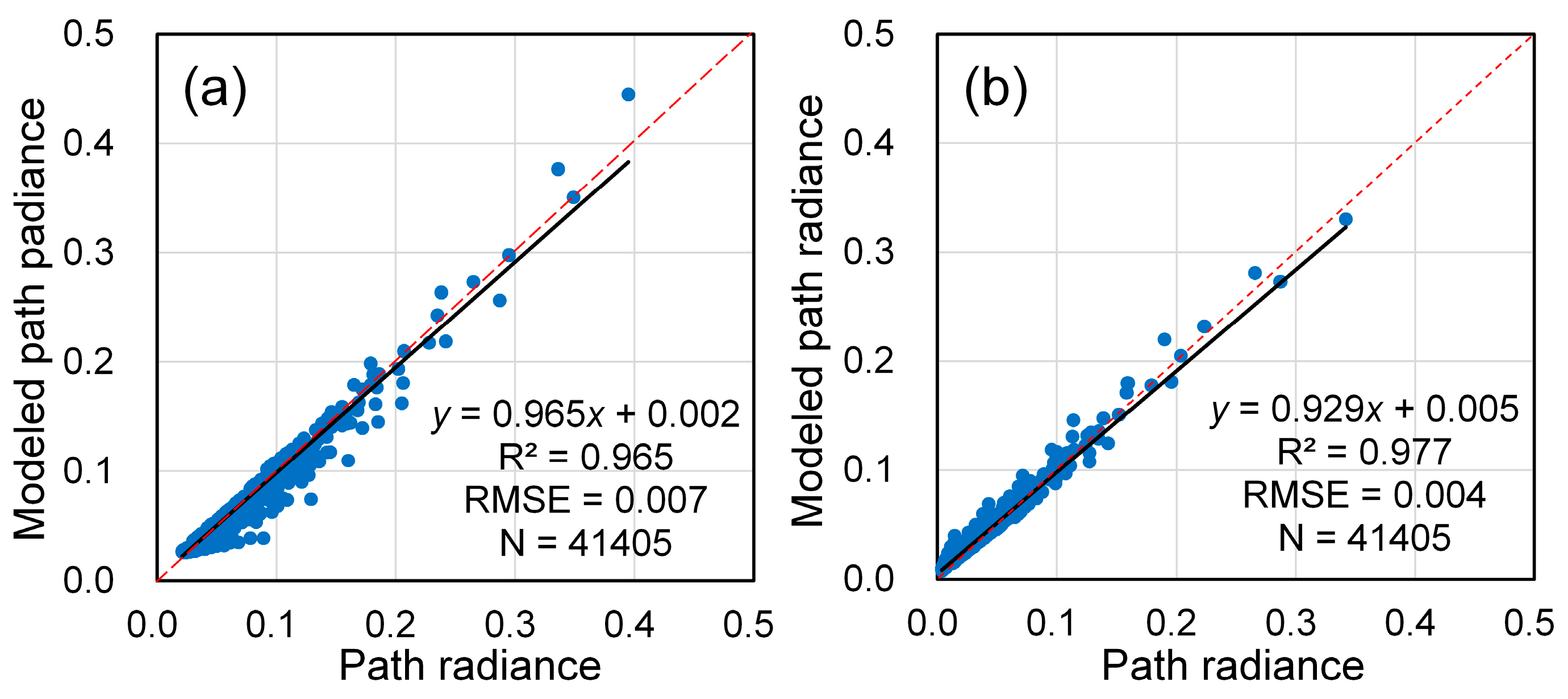
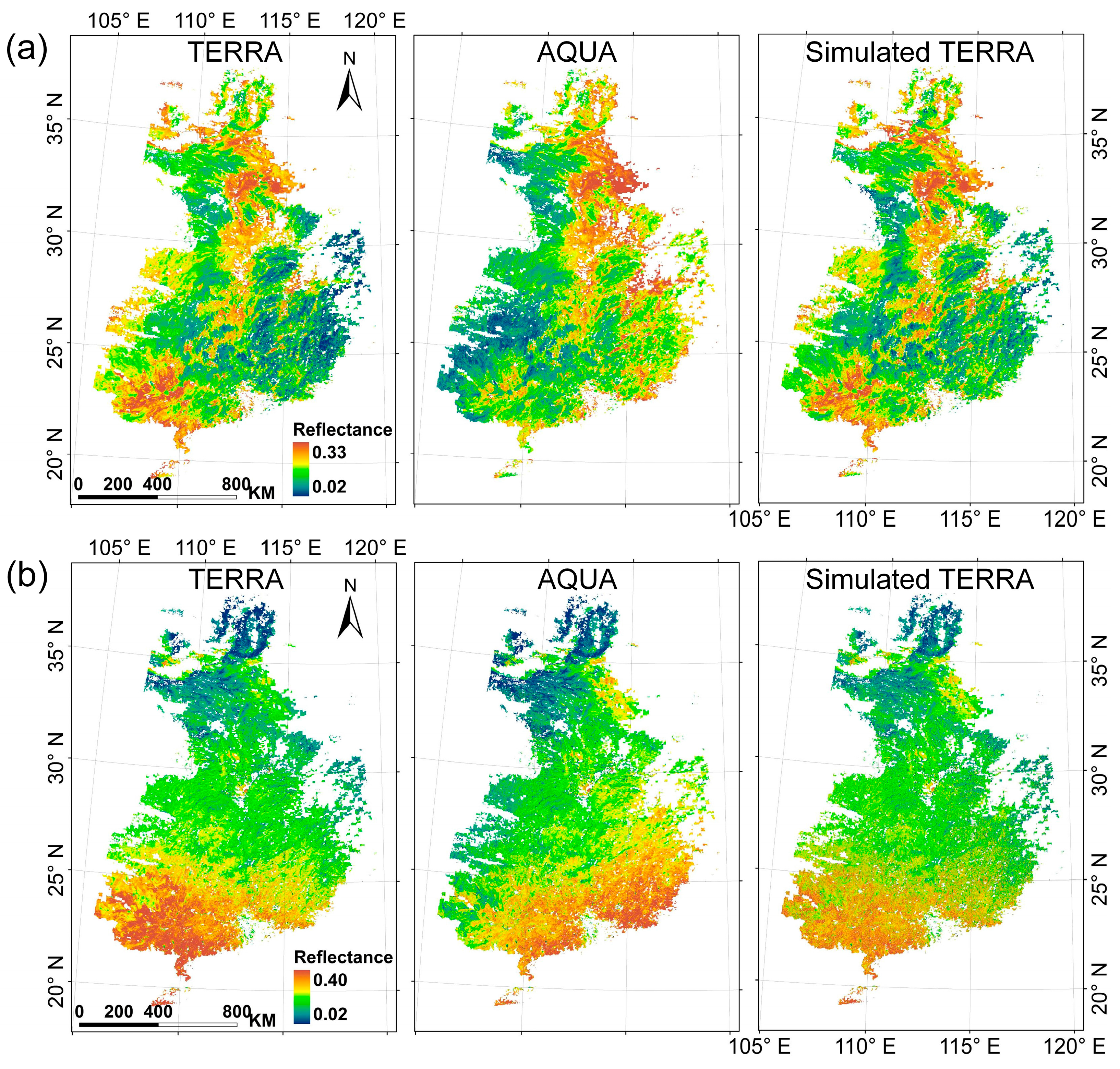
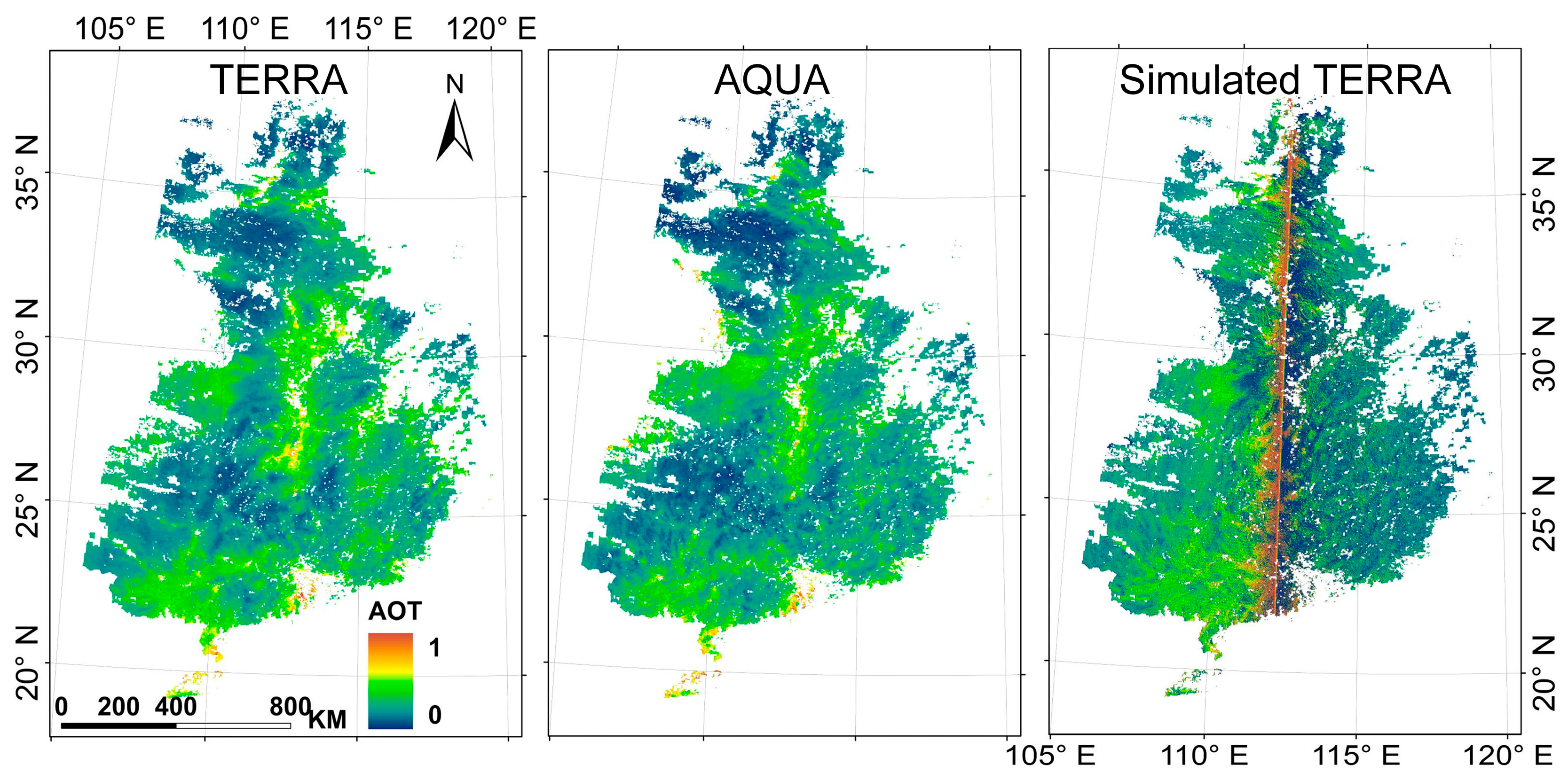

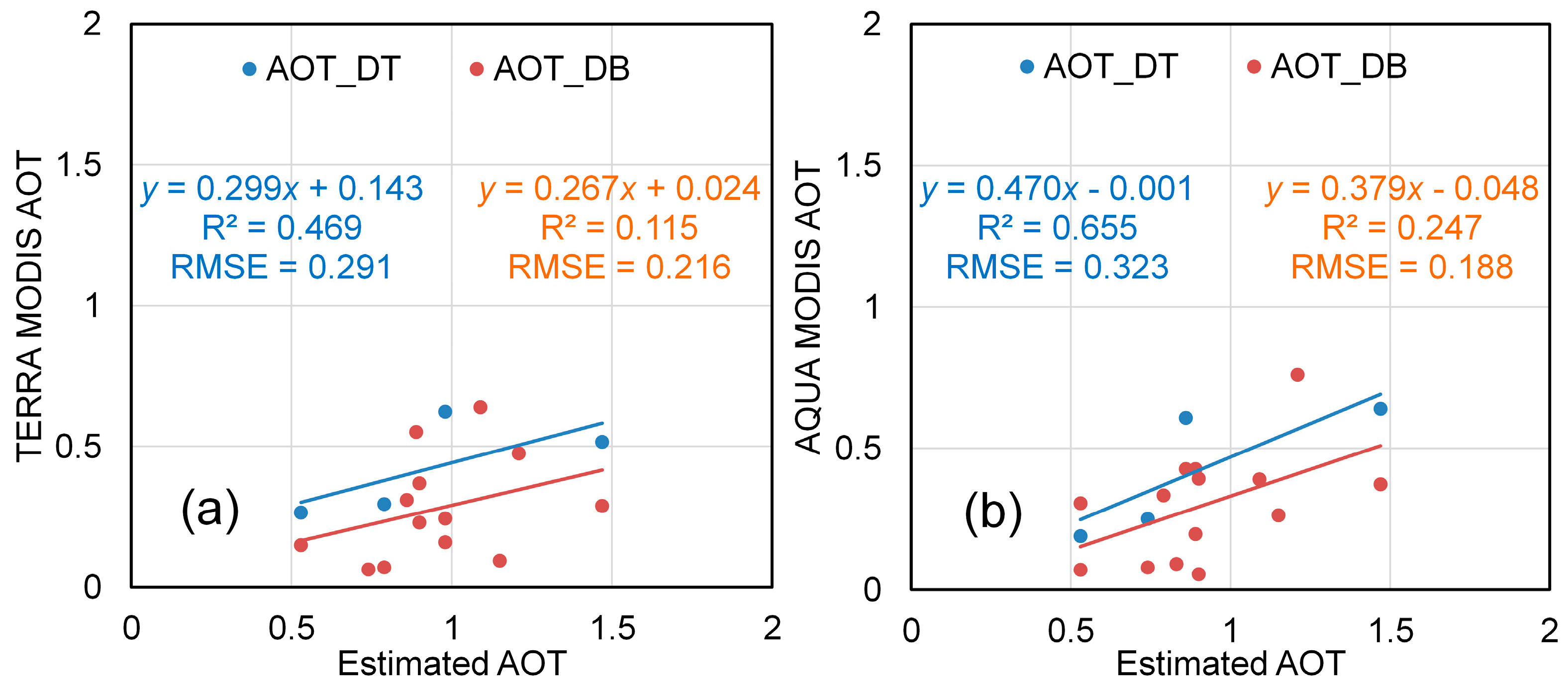
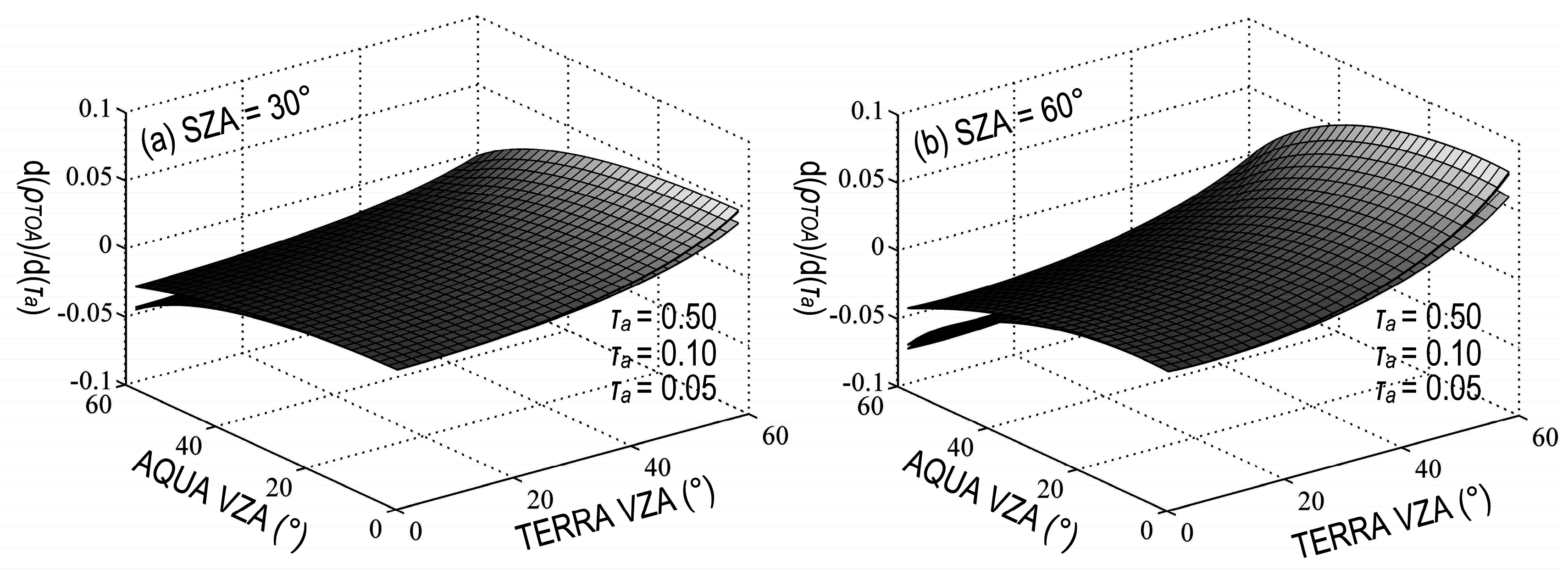
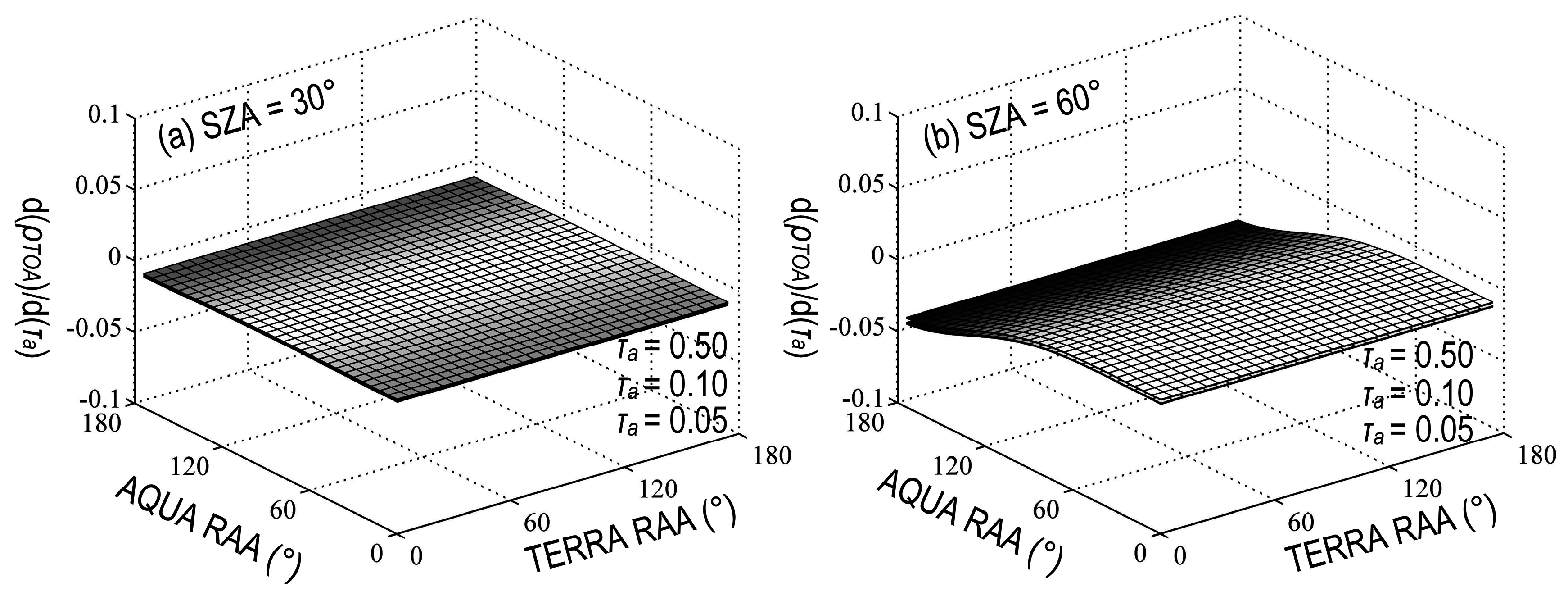
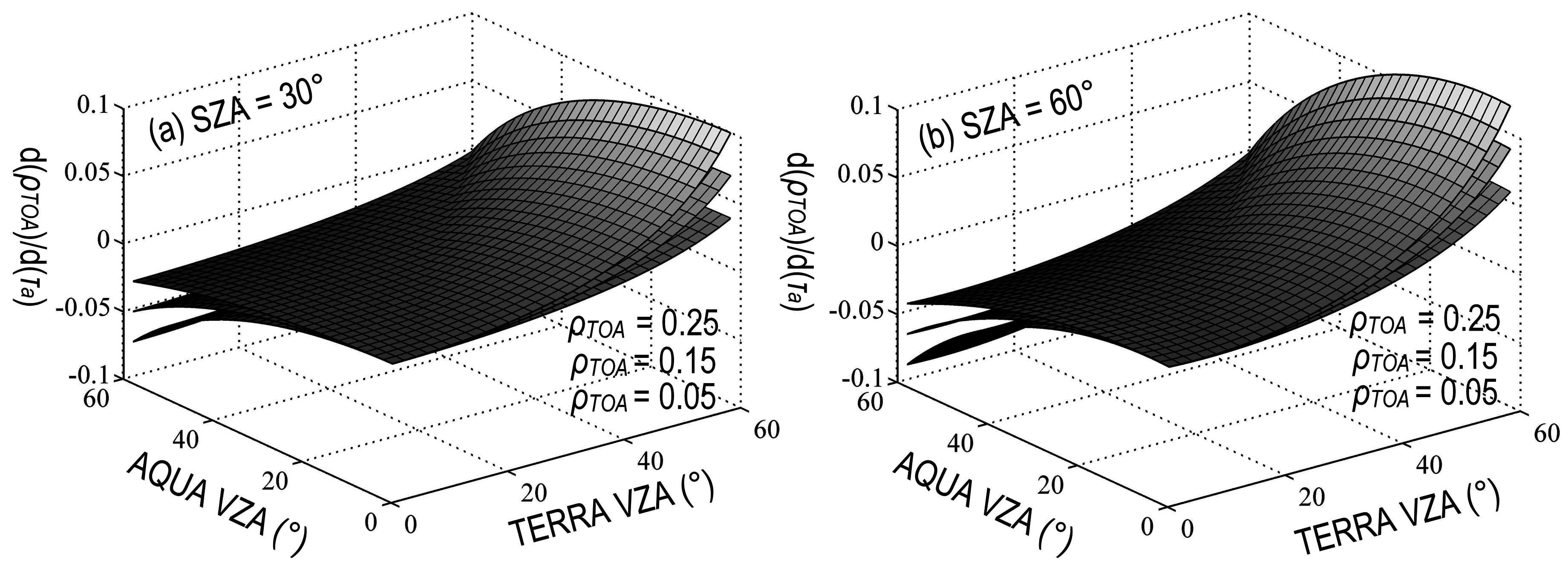
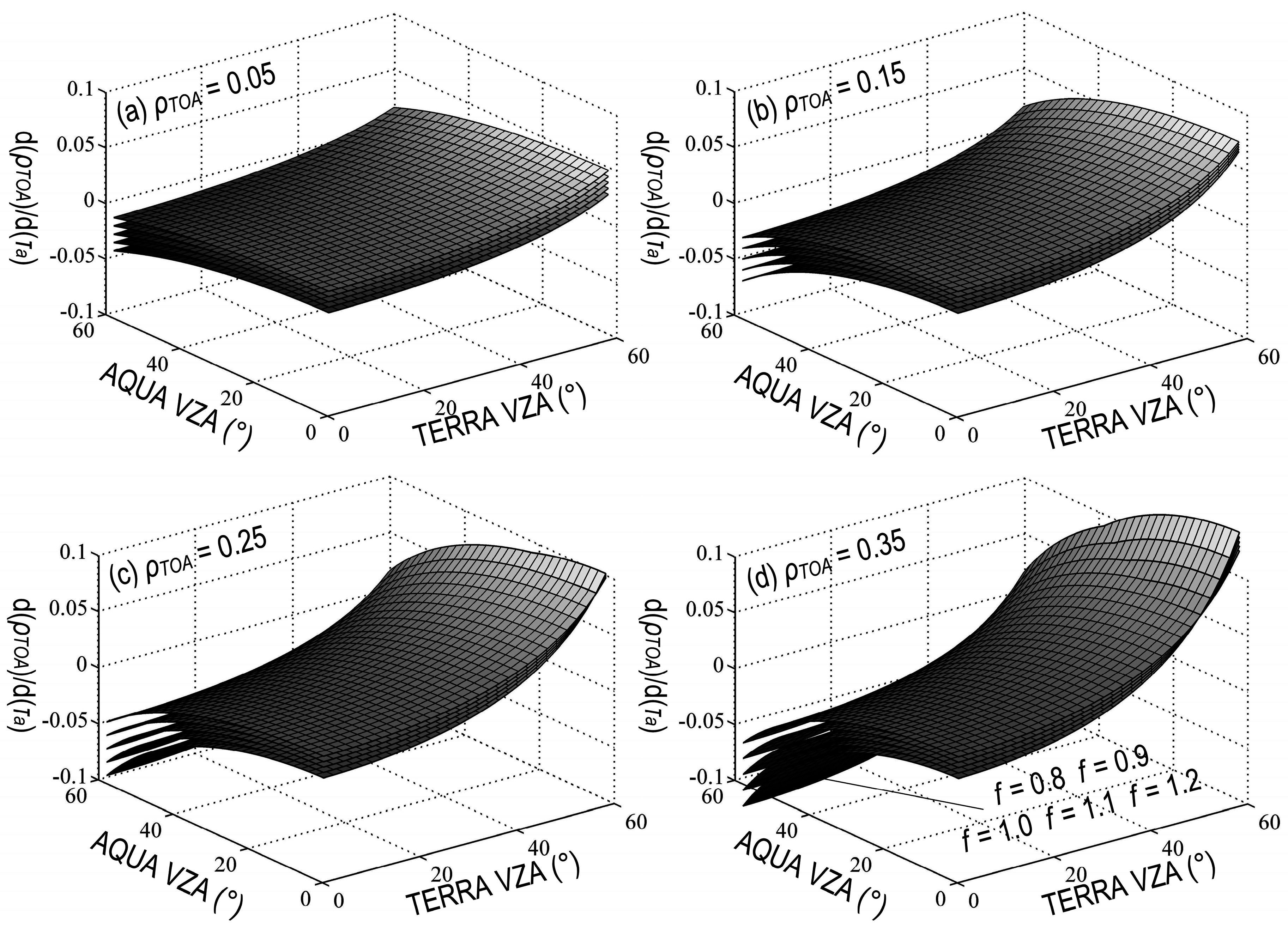
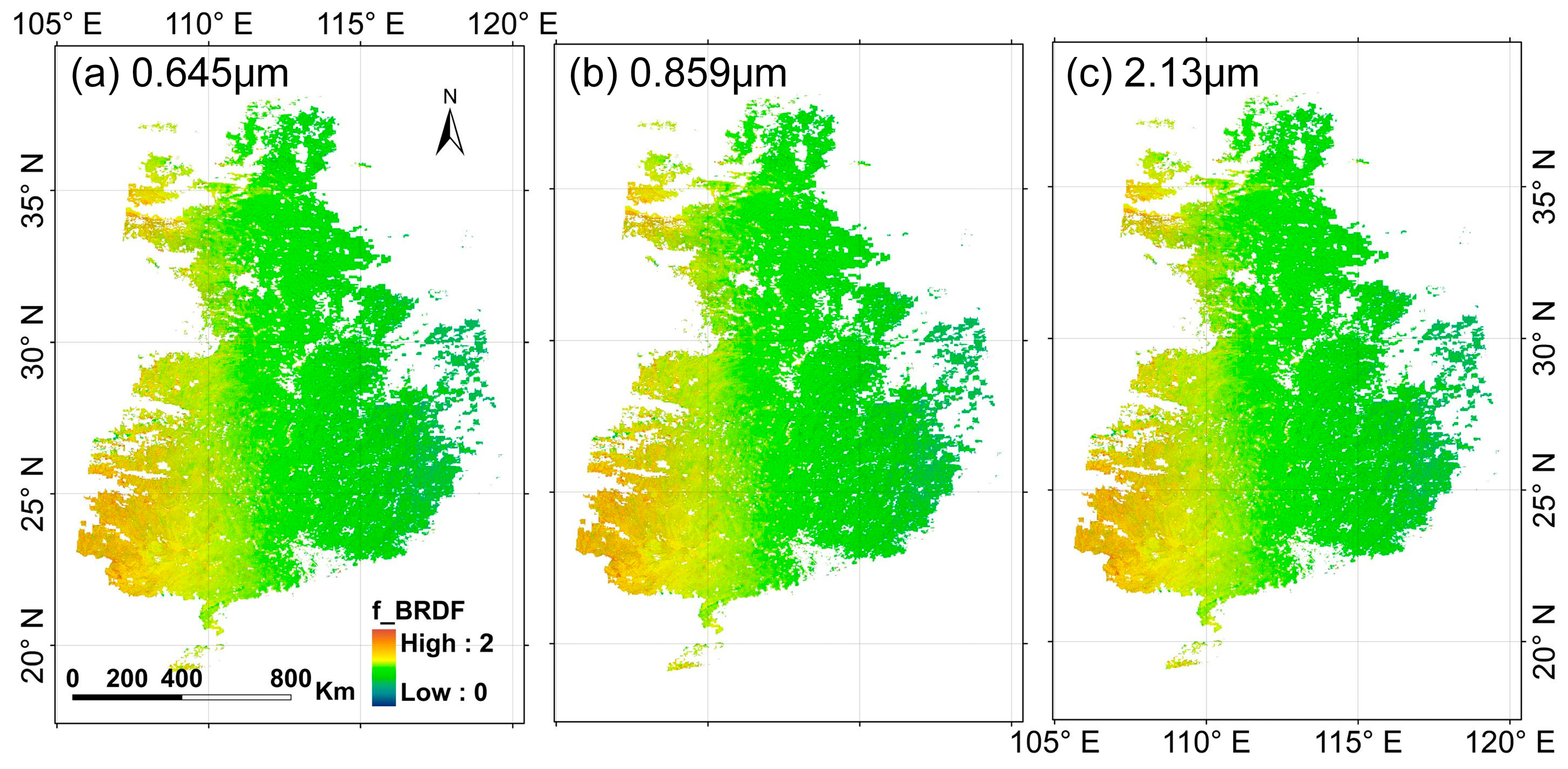

| Symbols | Definitions | Dimension/Units |
|---|---|---|
| ρas, ρrs | Single scattering reflectance of aerosol and Rayleigh | Dimensionless |
| τa, τr | Optical thickness of aerosol and Rayleigh scattering | Dimensionless |
| ωa, ωr | Single scattering albedo of aerosol and Rayleigh scattering | Dimensionless |
| Pa, Pr | Scattering phase function of aerosol and Rayleigh scattering | sr−1 |
| pa, pr | Intermediate variables related to Pa and Pr | sr−1 |
| θs, θv | Solar zenith angle (SZA) and sensor zenith angle (VZA) | Degrees |
| μs, μv | μs = cos(θs) and μv = cos(θv) | Dimensionless |
| ρF(θ) | Fresnel reflection coefficient for angle θ | Dimensionless |
| PD(θ) | Draine’s phase function at angle θ | sr−1 |
| γ± | Scattering angle in forward (+) and backward (-) directions | Degrees |
| α, g | Parameters of Draine’s phase function | Dimensionless |
| ρ | Surface reflectance | Dimensionless |
| ρpath | Total path radiance caused by aerosol and Rayleigh scattering | Dimensionless |
| ρTOA | Top-of-atmosphere reflectance | Dimensionless |
| λ | Wavelength | nm |
| Δφ | Difference between solar and view azimuth angles | Degrees |
| T | Atmospheric scattering | Dimensionless |
| Tg | Atmospheric absorption | Dimensionless |
| TOC | Total ozone concentration | cm·atm−1 |
| TPW | Total precipitable water vapor | g·cm−2 |
| BRDF | Bidirectional reflectance distribution function | Dimensionless |
| fBRDF | BRDF adjustment factor | Dimensionless |
| Validation Items | Data Sources | Data for Comparison | Metrics |
|---|---|---|---|
| Band ratioing technique | BRDF dataset | Band ratios | R2 |
| Path radiance approximation | 6S calculations | Path radiances | R2, RMSE |
| TERRA-MODIS relationship | MOD(MYD) 02/03/04/07 | TOA reflectances | ME ± SD |
| TERRA-MODIS AOT retrieval | MOD(MYD) 02/03/04/07 | AOT retrievals | ME ± SD |
| TERRA-MODIS AOT retrieval | Sunphotometer data | AOT retrievals | R2, RMSE |
© 2016 by the authors; licensee MDPI, Basel, Switzerland. This article is an open access article distributed under the terms and conditions of the Creative Commons Attribution (CC-BY) license (http://creativecommons.org/licenses/by/4.0/).
Share and Cite
Fan, X.; Liu, Y. Exploiting TERRA-AQUA MODIS Relationship in the Reflective Solar Bands for Aerosol Retrieval. Remote Sens. 2016, 8, 996. https://doi.org/10.3390/rs8120996
Fan X, Liu Y. Exploiting TERRA-AQUA MODIS Relationship in the Reflective Solar Bands for Aerosol Retrieval. Remote Sensing. 2016; 8(12):996. https://doi.org/10.3390/rs8120996
Chicago/Turabian StyleFan, Xingwang, and Yuanbo Liu. 2016. "Exploiting TERRA-AQUA MODIS Relationship in the Reflective Solar Bands for Aerosol Retrieval" Remote Sensing 8, no. 12: 996. https://doi.org/10.3390/rs8120996







